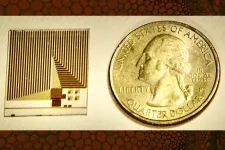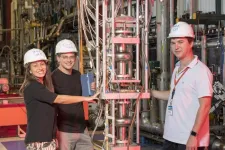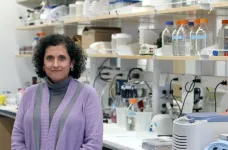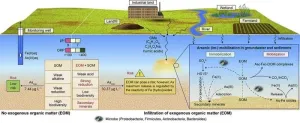(Press-News.org) CAMBRIDGE, MA -- Drawing inspiration from natural sensory systems, an MIT-led team has designed a novel sensor that could detect the same molecules that naturally occurring cell receptors can identify.
In work that combines several new technologies, the researchers created a prototype sensor that can detect an immune molecule called CXCL12, down to tens or hundreds of parts per billion. This is an important first step to developing a system that could be used to perform routine screens for hard-to-diagnose cancers or metastatic tumors, or as a highly biomimetic electronic “nose,” the researchers say.
“Our hope is to develop a simple device that lets you do at-home testing, with high specificity and sensitivity. The earlier you detect cancer, the better the treatment, so early diagnostics for cancer is one important area we want to go in,” says Shuguang Zhang, a principal research scientist in MIT’s Media Lab.
The device draws inspiration from the membrane that surrounds all cells. Within such membranes are thousands of receptor proteins that detect molecules in the environment. The MIT team modified some of these proteins so that they could survive outside the membrane, and anchored them in a layer of crystallized proteins atop an array of graphene transistors. When the target molecule is detected in a sample, these transistors relay the information to a computer or smartphone.
This type of sensor could potentially be adapted to analyze any bodily fluid, such as blood, tears, or saliva, the researchers say, and could screen for many different targets simultaneously, depending on the type of receptor proteins used.
“We identify critical receptors from biological systems and anchor them onto a bioelectronic interface, allowing us to harvest all those biological signals and then transduce them into electrical outputs that can be analyzed and interpreted by machine-learning algorithms,” says Rui Qing, a former MIT research scientist who is now an associate professor at Shanghai Jiao Tong University.
Qing and Mantian Xue PhD ’23, are the lead authors of the study, which appears today in Science Advances. Along with Zhang, Tomás Palacios, director of MIT’s Microsystems Laboratory and a professor of electrical engineering and computer science, and Uwe Sleytr, an emeritus professor at the Institute of Synthetic Bioarchitectures at the University of Natural Resources and Life Sciences in Vienna, are senior authors of the paper.
Free from membranes
Most current diagnostic sensors are based on either antibodies or aptamers (short strands of DNA or RNA) that can capture a particular target molecule from a fluid such as blood. However, both of these approaches have limitations: Aptamers can be easily broken down by body fluids, and manufacturing antibodies so that every batch is identical can be difficult.
One alternative approach that scientists have explored is building sensors based on the receptor proteins found in cell membranes, which cells use to monitor and respond to their environment. The human genome encodes thousands of such receptors. However, these receptor proteins are difficult to work with because once removed from the cell membrane, they only maintain their structure if they are suspended in a detergent.
In 2018, Zhang, Qing, and others reported a novel way to transform hydrophobic proteins into water-soluble proteins, by swapping out a few hydrophobic amino acids for hydrophilic amino acids. This approach is called the QTY code, after the letters representing the three hydrophilic amino acids — glutamine, threonine, and tyrosine — that take the place of hydrophobic amino acids leucine, isoleucine, valine, and phenylalanine.
“People have tried to use receptors for sensing for decades, but it is challenging for widespread use because receptors need detergent to keep them stable. The novelty of our approach is that we can make them water-soluble and can produce them in large quantities, inexpensively,” Zhang says.
Zhang and Sleytr, who are longtime collaborators, decided to team up to try to attach water-soluble versions of receptor proteins to a surface, using bacterial proteins that Sleytr has studied for many years. These proteins, known as S-layer proteins, are found as the outermost surface layer of the cell envelope in many types of bacteria and archaea.
When S-layer proteins are crystallized, they form coherent monomolecular arrays on a surface. Sleytr had previously shown that these proteins can be fused with other proteins such as antibodies or enzymes. For this study, the researchers, including senior scientist Andreas Breitwieser, who is also a co-author in the paper, used S-layer proteins to create a very dense, immobilized sheet of a water-soluble version of a receptor protein called CXCR4. This receptor binds to a target molecule called CXCL12, which plays important roles in several human diseases including cancer, and to an HIV coat glycoprotein, which is responsible for virus entry into human cells.
“We use these S-layer systems to allow all these functional molecules to attach to a surface in a monomolecular array, in a very well-defined distribution and orientation,” Sleytr says. “It’s like a chessboard where you can arrange different pieces in a very precise manner.”
The researchers named their sensing technology RESENSA (Receptor S-layer Electrical Nano Sensing Array).
Sensitivity with biomimicry
These crystallized S-layers can be deposited onto nearly any surface. For this application, the researchers attached the S-layer to a chip with graphene-based transistor arrays that Palacios’ lab had previously developed. The single-atomic thickness of the graphene transistors makes them ideal for the development of highly sensitive detectors.
Working in Palacios’ lab, Xue adapted the chip so that it could be coated with a dual layer of proteins — crystallized S-layer proteins attached to water-soluble receptor proteins. When a target molecule from the sample binds to a receptor protein, the charge of the target changes the electrical properties of the graphene in a way that can be easily quantified and transmitted to a computer or smartphone connected to the chip.
“We chose graphene as the transducer material because it has excellent electrical properties, meaning it can better translate those signals. It has the highest surface-to-volume ratio because it's a sheet of carbon atoms, so every change on the surface, caused by the protein binding events, translates directly to the whole bulk of the material,” Xue says.
The graphene transistor chip can be coated with S-layer-receptor proteins with a density of 1 trillion receptors per square centimeter with upward orientation. This allows the chip to take advantage of the maximum sensitivity offered by the receptor proteins, within the clinically relevant range for target analytes in human bodies. The array chip integrates more than 200 devices, providing a redundancy in signal detection that helps to ensure reliable measurements even in the case of rare molecules, such as the ones that could reveal the presence of an early-stage tumor or the onset of Alzheimer’s disease, the researchers say.
Thanks to the use of QTY code, it is possible to modify naturally existing receptor proteins that could then be used, the researchers say, to generate an array of sensors in a single chip to screen virtually any molecule that cells can detect. “What we are aiming to do is develop the basic technology to enable a future portable device that we can integrate with cell phones and computers, so that you can do a test at home and quickly find out whether you should go to the doctor,” Qing says.
###
The research was funded by the National Science Foundation, MIT Institute for Soldier Nanotechnologies, and Wilson Chu of Defond Co. Ltd.
END
New sensor mimics cell membrane functions
The device detects the same molecules that cell receptors do, and may enable routine early screening for cancers and other diseases.
2023-07-21
ELSE PRESS RELEASES FROM THIS DATE:
The Pacific slope of Peru is greening, and this is not good news
2023-07-21
Analysing satellite data spanning the past 20 years, the research team based at the Cavendish Laboratory in Cambridge examined how vegetation has been changing along the Pacific coast of Peru and northern Chile. This area is known for its unique and delicate arid and semi-arid environments.
The analysis revealed that certain areas experienced positive vegetation growth, known as greening, while others displayed negative trends, referred to as browning. Unsurprisingly, the changes in vegetation are influenced by things like farming and urban development or change in ...
Dark SRF experiment at Fermilab demonstrates ultra-sensitivity for dark photon searches
2023-07-21
Scientists working on the Dark SRF experiment at the U.S. Department of Energy’s Fermi National Accelerator Laboratory have demonstrated unprecedented sensitivity in an experimental setup used to search for theorized particles called dark photons.
Researchers trapped ordinary, massless photons in devices called superconducting radio frequency cavities to look for the transition of those photons into their hypothesized dark sector counterparts. The experiment has put the world’s best constraint on the dark photon existence in a specific mass range, as ...
Extracellular vesicles could aid spread of scleroderma-caused fibrosis throughout body
2023-07-21
Extracellular vesicles, responsible for cell-to-cell communication, might be a driver of fibrosis in systemic sclerosis, according to a recent paper in Arthritis and Rheumatology.
Characterized by stiff and hardening tissue known as fibrosis, systemic sclerosis – also known as scleroderma – can affect the skin as well as other organs. Most research has focused on the pathology and starting point of fibrosis, but researchers at the Medical University of South Carolina are focusing ...
Ricardo Valerdi named Head of Systems and Industrial Engineering at the University of Arizona
2023-07-21
Ricardo Valerdi was selected as head of the Department of Systems and Industrial Engineering after a national search that yielded a highly competitive pool of candidates after serving as interim head for the 2022-2023 academic year.
“When I joined SIE 12 years ago, it looked very different,” said Valerdi. “Today we have a new generation of talented and ambitious faculty who are impacting our society’s Grand Challenges in manufacturing, transportation, aerospace ...
BioIVT to discuss its pivotal role in liquid biopsy research at the AACC Annual Scientific Meeting and Clinical Lab Expo
2023-07-21
BioIVT, a global research partner and biospecimen solutions provider for drug and diagnostic development, today announced that it will highlight the integral role it is playing in liquid biopsy research at the American Association for Clinical Chemistry (AACC) Annual Scientific Meeting and Clinical Lab Expo. This conference will be held from July 23-27 at the Anaheim Convention Center in Anaheim, CA.
“Liquid biopsy research can revolutionize the way we detect, diagnose, and treat diseases. However, several issues need to be resolved before it can reach its full potential. They include adopting ...
Father’s psychiatric diagnosis increases risk of preterm birth, study reports
2023-07-21
Babies are more likely to be born prematurely when either their father or mother has had a psychiatric diagnosis, according to a study conducted by researchers at the Icahn School of Medicine at Mount Sinai and the Karolinska Institutet and published July 20 in the open access journal PLOS Medicine.
The research shows, for the first time, that the risk of preterm birth is higher in infants whose father or mother has a psychiatric diagnosis than in those whose parents do not, and higher still when both parents have such diagnoses.
Preterm ...
Multi-society statement on US Supreme Court ruling on students for fair admissions
2023-07-21
ROCKVILLE, MD—JULY 19, 2023 – As organizations representing a wide range of scientific, engineering, and mathematical disciplines, we will not be deterred by the U.S. Supreme Court ruling on race considerations in college and university admissions.
America’s inherent strength and economic competitiveness among nations is its domestic and international talent across every race, ethnicity, gender, and geography. To meet current and emerging job demands and retain our research and development leadership globally, we must broaden who participates in science, technology, engineering, mathematics, and medicine. Doing so will improve lives, advance our nation’s living standards, ...
Harnessing machine learning for early cancer detection in primary care
2023-07-21
“[Machine learning] has the potential to transform early cancer detection in primary care [...]”
BUFFALO, NY- July 21, 2023 – A new editorial paper was published in Oncoscience (Volume 10) on June 9, 2023, entitled, “Transforming early cancer detection in primary care: harnessing the power of machine learning.”
Cancer remains a significant global health burden, and early detection plays a crucial role in improving patient outcomes. Primary care settings serve as frontline gatekeepers, providing an opportunity for early detection through symptom assessment and ...
New study uncovers potential risk of arsenic release from sediment under organic matter influence
2023-07-21
Researchers from the Chinese Research Academy of Environmental Sciences have conducted a study to assess the impact of environmental factors and microbial communities on the mobilization of arsenic (As). The findings, published in Volume 15 of the journal Environmental Science and Ecotechnology, reveal important insights into the biogeochemical processes involved in As release. The study focused on processes such as desorption, reduction, complexation, and co-precipitation that affect the As behaviour in the environment. The interaction ...
$20 million awarded to lead next century of heart disease and stroke scientific research
2023-07-21
DALLAS, July 21, 2023 — More than 100 scientists from across the U.S. are receiving special grants to support their research work in finding innovative solutions to fight heart disease and stroke. The grants, totaling $20 million, are part of the Second Century of Science Initiative of the American Heart Association, the world’s leading voluntary organization dedicated to a world of longer, healthier lives. The financial awards are announced as the Association, the largest non-government supporter of heart and brain health research in the U.S., prepares to celebrate ...
LAST 30 PRESS RELEASES:
Numbers in our sights affect how we perceive space
SIMJ announces global collaborative book project in commemoration of its 75th anniversary
Air pollution exposure and birth weight
Obstructive sleep apnea risk and mental health conditions among older adults
How talking slows eye movements behind the wheel
The Ceramic Society of Japan’s Oxoate Ceramics Research Association launches new international book project
Heart-brain connection: international study reveals the role of the vagus nerve in keeping the heart young
Researchers identify Rb1 as a predictive biomarker for a new therapeutic strategy in some breast cancers
Survey reveals ethical gaps slowing AI adoption in pediatric surgery
Stimulant ADHD medications work differently than thought
AI overestimates how smart people are, according to HSE economists
HSE researchers create genome-wide map of quadruplexes
Scientists boost cell "powerhouses" to burn more calories
Automatic label checking: The missing step in making reliable medical AI
Low daily alcohol intake linked to 50% heightened mouth cancer risk in India
American Meteorological Society announces Rick Spinrad as 2026 President-Elect
Biomass-based carbon capture spotlighted in newly released global climate webinar recording
Illuminating invisible nano pollutants: advanced bioimaging tracks the full journey of emerging nanoscale contaminants in living systems
How does age affect recovery from spinal cord injury?
Novel AI tool offers prognosis for patients with head and neck cancer
Fathers’ microplastic exposure tied to their children’s metabolic problems
Research validates laboratory model for studying high-grade serous ovarian cancer
SIR 2026 delivers transformative breakthroughs in minimally invasive medicine to improve patient care
Stem Cell Reports most downloaded papers of 2025 highlight the breadth and impact of stem cell research
Oxford-led study estimates NHS spends around 3% of its primary and secondary care budget on the health impacts of heat and cold in England
A researcher’s long quest leads to a smart composite breakthrough
Urban wild bees act as “microbial sensors” of city health.
New study finds where you live affects recovery after a hip fracture
Forecasting the impact of fully automated vehicle adoption on US road traffic injuries
Alcohol-related hospitalizations from 2016 to 2022
[Press-News.org] New sensor mimics cell membrane functionsThe device detects the same molecules that cell receptors do, and may enable routine early screening for cancers and other diseases.









